China Cycling Travelogues
Do you have a China cycling travelogue you would like
to share here?
Contact us for details.
Bill Weir
Cycling from Thailand to China
"E-Mails and Photos from a Four-Month Bicycle Adventure Beginning in Bangkok and ending in Chengdu"
CHINA
Colorful towns and a big cave in Southeastern Yunnan
Copyright © Bill Weir, 2005
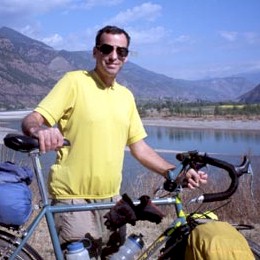
Skip to Bill Weir: Thailand | Laos | China 1 - Yunnan | China 2 - Yunnan | China 3 - Yunnan | China 4 - Yunnan | China 5 - Yunnan | China 6 - Sichuan | China 7 - Sichuan
CHINA
Colorful towns and a big cave in Southeastern Yunnan
Kunming, China
3 March 2005
Snowbound in Kunming
Dear Friends and Family,
From the cloud-enshrouded town of upper Yuanyang high on the slopes of the Ailo Shan mountain range, I put on all of my warm clothing and began the long descent to the Hong He (Red River). Despite the cold fog, the market in town was in full swing; I suppose locals have become accustomed to the clouds that regularly hang out here! After 10 km of descent I got below the clouds and had my first view of the Hong He, still far below. The landscape and vegetation had changed dramatically from the tropical south; gone were the dense forests and lush greenery. Dry hills supported only meager vegetation, and farmers could grow crops only with irrigation.
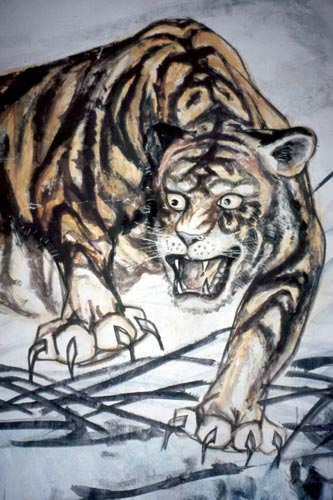
Baohua Si temple (1670-75) in Gejiu
My guidebook, Lonely Planet Southwest China (2002), reported that the distance from upper Yuanyang to my next destination, Gejiu, was 171 km, which would be a two-day ride for me. But just 20 km down the valley I came across a sign for "Gejiu—36 km" so I decided to go for it. None of my maps showed this new highway, but it was smooth and wide. Unfortunately it was all uphill, and darkness descended as I neared the top. When I was just 3 km from town, the mountains still rose high above and I began wondering if maybe this highway had a tunnel just ahead. Well it did, and the Chinese don't like cyclists riding through their tunnels. I switched to high gear and zoomed through! But I was spotted—and nabbed—but not before getting through the tunnel. After a lecture (in Chinese) about not riding in the tunnel, I was free to continue into town. I found Gejiu a very unusual place. It's a tin mining town, and I could see workings and mills on the outskirts, but that didn't detract from the town's attractive setting on a lake and ringed by mountains. Level land was scarce, so people lived and worked in high-rise buildings. I explored some of the markets in this "mini-Manhattan" and walked south to Baohua Park, filled with temples and gardens. Feeling lazy, I climbed the Qiling Shan Mountain high above via a little cable car to enjoy the views.
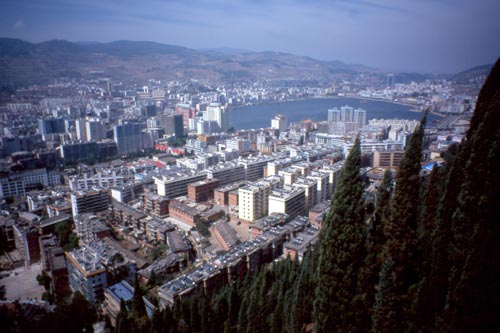
Yunnan has only 5% flat land, so the Chinese make the most of it! Gejiu and Jin Hi (lake) from cable car up Qiling Shan
Tonghai, my next big destination, lay just a day away. I swooped down into the valley north of Gejiu, then took a shortcut over some hills to the main highway. A white haze, probably from the non-ferrous metal plant, filled the valley and left a metallic taste in the back of my mouth. I felt sorry for the people who lived and worked in the valley and wondered if the pollution was also contaminating the crops. I was out of the haze by the time I hit the main highway, which turned out to be just a bumpy country lane. A new freeway now carried most of the traffic; I found this to be the case for the rest of my ride to Kunming. So I enjoyed the mostly quiet cycling through villages, fields, and hills. All flat land had been taken over by the farmers and lovingly cared for; some farmers even irrigated their crops by ladling water out of buckets.
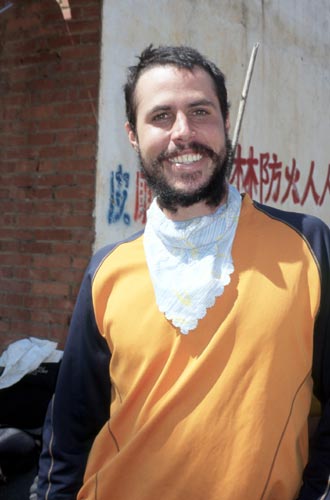
"John from California" taking a break from cycling; northwest of Gejiu. John later made his way to Shanghai, then took a ferry to Japan.
I was surprised, as usual, to meet another cyclist. "John from California" was tramping around Asia for a couple years and had lately been cycling the length of Vietnam from Saigon. He was staying with families (which can mean a visit from the police in Vietnam and China) and camping most of the time, which he had been enjoying. What amazed me was that he had no map or guidebook and only a vague plan to ride to Kunming and on to Beijing and Japan.
Soon I came to Swallows Cave, one of the biggest in China and a major tourist attraction. I not only got a good look at the cave, but the full "Chinese experience." The Chinese just aren't satisfied unless their caves have entertainment, temples, colored lights, snack bar, gift shop, and a "smoking room." I joined a tour (required), which was composed of local Hani women dressed in traditional finery and some boozy-breathed men. Just inside the spectacular entrance, through which the Lu River runs, our group was treated to the sight of a man free climbing high on the 50-meter-high walls. He was demonstrating the technique of collecting swallow nests, done at the end of the nesting season in August. The nests, composed of swallow saliva and grass, are used to make soup and tonics. Tasty, I wonder? The nearly two-hour tour continued on trails deep inside and up to higher levels, passing massive cave features illuminated in bright colors. For the return trip, we boarded dragon boats on the river for the journey in near darkness back to the entrance. I explored some of the cave temples dedicated to Buddha and Chinese gods before hopping back on my bike for the ride into Jianshui.
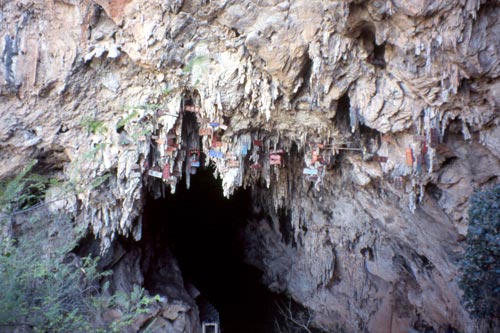
Entrance to Swallows Cavern. Harvestors of birds nests left the banners high above the entrance.
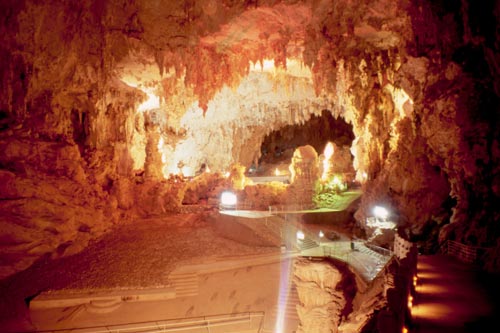
Inside Swallows Cavern. This room was the farthest in on our tour.
Normally the Chinese favor characterless architecture. A concrete box covered with bathroom tiles suits them just fine. But in Jianshui, many of the traditional buildings survived. I spent a day touring the huge Confucius Temple, the Zhu Family Gardens (a sprawling family house compound), and the Chaoyang Gate (an art exhibit was inside). The next day I had an enjoyable ramble by bicycle out to the traditional Tuanshan village, where a young woman took me on a tour of house courtyards and the temple, all filled with fine wood and stone carvings. On the way back to town I visited the 17-arch stone Twin Dragon Bridge with an ornate three-story pavilion in the middle and a smaller one at the south end. Lastly on the ride, I scrambled up a hill to see the solid stone Wenbi Ta, a 31.4-meter-high pagoda shaped like a calligraphy brush.
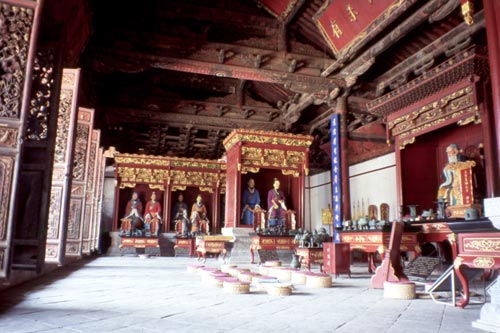
Xianshi Hall (for consecrating Confucius) in Confucius Temple, Jianshui. This hall contains Confucius, 4 sages, and 12 philosphers of all the dynasties.
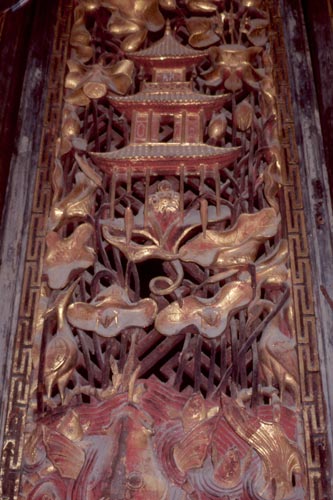
Wood carving in Tuanshan Village, 13 km west of Jianshui. Elaborate wood carvings decorate doors of temples and traditional houses.
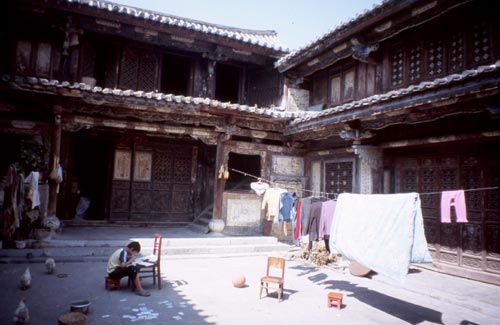
A lot of skill went into the wood carving of this old house in Tuanshan Village.
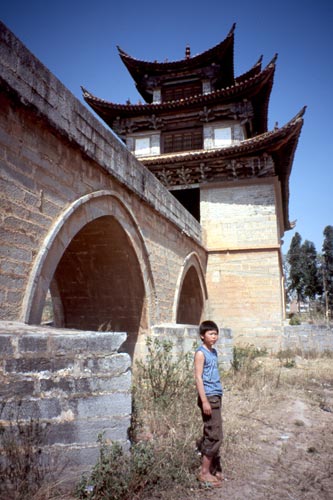
Hardly any water flows under the bridge today! Twin Dragon Bridge, 5 km west of Jianshui, has 17 arches and two gates.
The hilly ride north of Jianshui crossed a couple mountain ranges and followed a large river for a while. But at the top of the last pass, instead of the big downhill I expected, the road simply led straight into Tonghai. I took a day off to explore Xiu Shan, a 200-meter peak covered with old temples, gardens, and dense forests. A local English teacher, Albert, soon found me and invited me to his cafe near the entrance to the Xiu Shan. He's one of the rarest of rarities—a Chinese person who speaks good English. Albert runs a little cafe for the occasional western tourist, but his main business is teaching English. He also provides Internet, something I haven't been able to find during the previous two weeks. By the way, if you're looking for an Internet cafe in China, don't ask for "Internet" as most people will not have a clue to what you are saying. The correct word is something like "Yingtewan." Albert was very friendly and full of information. He filled me in on some of the mysteries of China. For example, I had been seeing boys who wrote long chalk messages in Chinese on the pavement, then would bow repeatedly. I assumed the boys were on some religious pilgrimage, but Albert explained that the boys were simply begging, and that the text complained about how needy they were and how the government failed to help them.
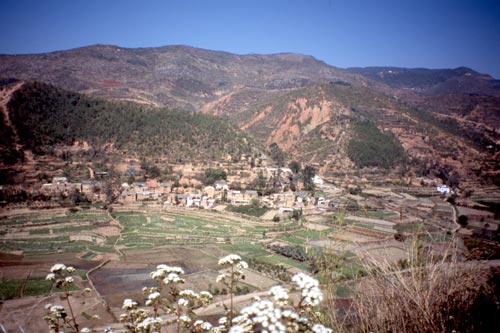
This valley is about half way on the old road from Jianshui to Tonghai.
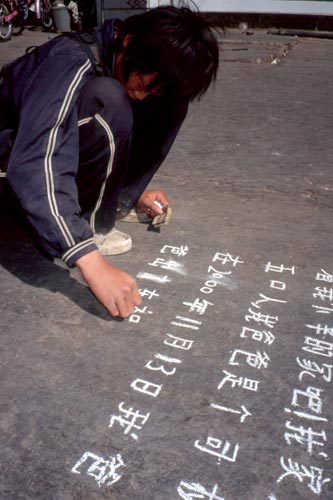
A young man telling his hard-luck story and begging for money in Tonghai.
From Tonghai I detoured west to the mud-brick Mongolian village of Xingmen. Seven hundred years ago the ancestors had come with Kublai Khan, then had later been stranded here during a regime change. The Mongols adapted to a sedentary life of fishing and farming; some of the women still wore tunics and had striped sleeves of bright colors. In Jiangchuan I stopped to see the Bronze Age Museum with some fine human and animal effigies unearthed in the area. Continuing north past the salty Xingyun Hu and deep Fuxian Hu lakes, I crossed a mountain range to plains surrounding a large lake, Dian, and continued to Chenggong, a short 30 km ride from Kunming.
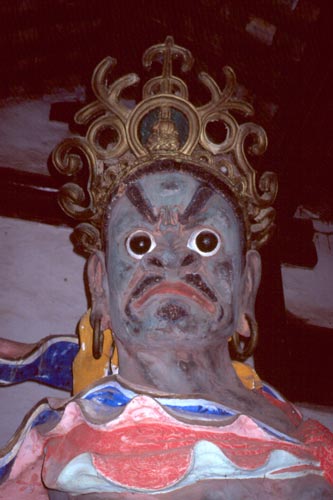
Yongjin Temple in Tonghai's Xiu Shan Park. A face only a mother could love.
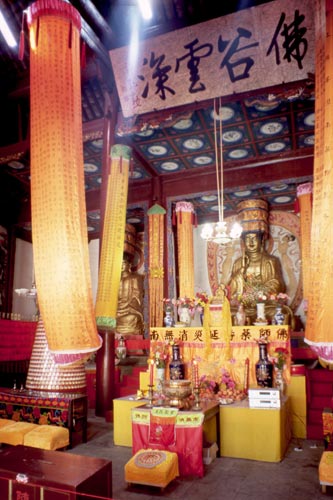
Yongjin Temple in Tonghai's Xiu Shan Park. Buddhas in the main hall of Yongjin Temple.
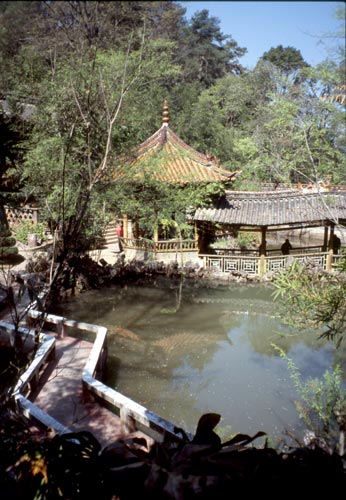
Evil spirits cannot cross zig-zag bridges, it's said. White Dragon Temple in Xiu Shan Park.
I arrived in Kuming to sunshine on March 1st, and had time to admire the flowers and see some sights. First I strolled through the beautifully landscaped campus of Kunming University, near where I'm staying. Next I crossed the street and wandered past the tulip-lined lakes of Cuihu (Green Lake) Park; lots of seagulls noisily sought handouts. A few blocks of walking east brought me to the main Buddhist temple in town, Yuantong Si. A path in the temple complex led through a series of gateways, across a stone bridge to a shrine hall on a little island, then another stone bridge to the main hall, filled with six giant statues; a new hall at the back had a large Thai-style Buddha, donated by the king of Thailand. Next I wandered into the Kunming Zoo, where a spacious area near the entrance held a family of the cute, raccoon-like lesser pandas. I felt sorry for other animals confined to tiny cages, such as an unfortunate snow leopard. Farther in the zoo I came across a circus act with lion tamers putting a group of lions and tigers through a series of tricks. The zoo wasn't the greatest place for animal lovers (the Chinese tend to tease, eat, and otherwise be cruel to wildlife). The aquarium in the zoo was better, but the real highlight for most visitors and me was the huge area of pink flowering trees at the top of the hill; it was the best floral display I've seen in Kunming. After taking in the flowers, I visited a nearby, upscale vegetarian restaurant; the crispy duck was very tasty and could have fooled many a carnivore!
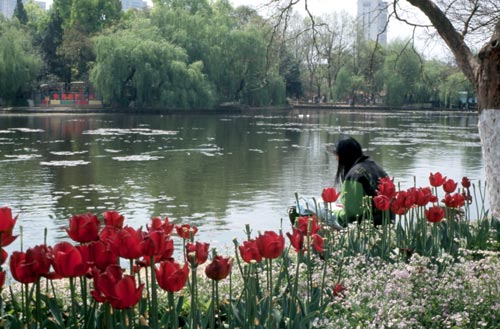
Ahh, peace and quiet in the middle of the city. Cuihu (Green Lake) Park, Kunming.
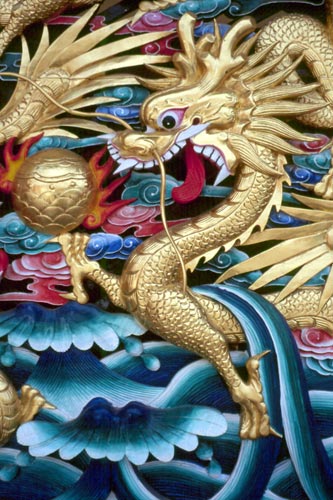
Wood carving in Yuantong Si, a large Buddhist temple in Kunming
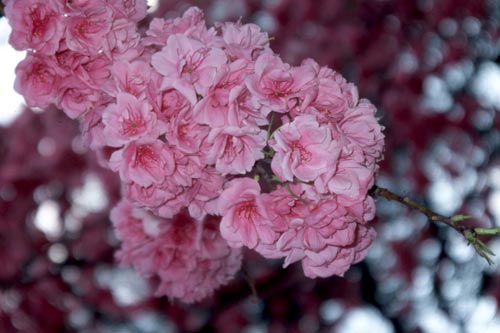
Hundreds of cherry, weeping Chinese crabapple, and other trees lined the paths. Enjoying the Flora in Kunming Zoo.
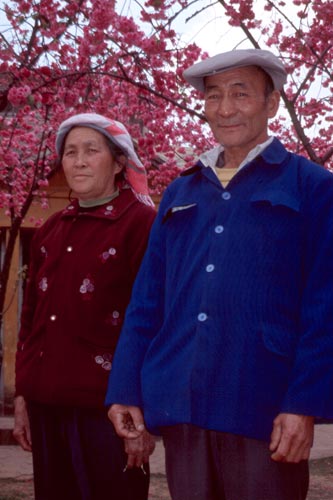
Chinese were lining up to have their portraits taken under the blossoms. Enjoying the Flora in Kunming Zoo.
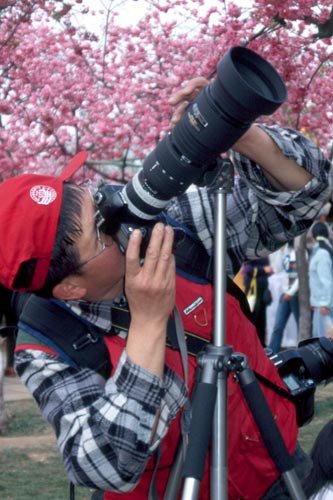
Cameras were clicking like crazy! Enjoying the Flora in Kunming Zoo.
Where to from here? If the snow and rain ever stop, I plan to head west to Dali, a picturesque old town on the shore of Erhai Lake. The town is famous among travelers as being one of a handful of places in China where one "can take a break from traveling." I won't need to do that because I'm fortunate to be traveling by bicycle! However I'll be enjoying the banana pancakes, culture, and scenery with the rest of the travelers.
From the "City of Snow and Cold,"
Bill and "Bessie Too the Bicycle"
BRRRR
Skip to Bill Weir: Thailand | Laos | China 1 - Yunnan | China 2 - Yunnan | China 3 - Yunnan | China 4 - Yunnan | China 5 - Yunnan | China 6 - Sichuan | China 7 - Sichuan
Bike China Adventures, Inc.
Home | Guided Bike Tours | Testimonials |
| Photos | Bicycle Travelogues
| Products | Info |
Contact Us
Copyright © Bike China Adventures, Inc., 1998-2012. All rights reserved.
